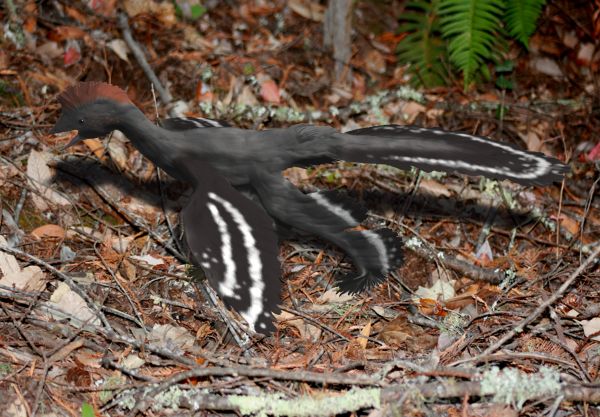
Anchiornis huxleyi, a troodontid maniraptoran coelurosaur from the late Jurassic of China.
Digital artwork by Nobu Tamura, via Wikipedia, GNU Free Documentation/Creative Commons Attribution
| Coelurosauria | ||
| The Vertebrates | Paraves |
| Vertebrates Home | Vertebrate | Vertebrate |
|
Abbreviated Dendrogram
Dinosauria
├─Ornithischia
└─┬─Sauropodomorpha
└─Theropoda
│
└─Coelurosauria
├─Tyrannosauroidea
└─┬─Ornithomimosauria
└─┬─Maniraptora
├─Therizinosauroidea
└─Metornithes
├─Alvarezsauridae
└─┬─Oviraptorosauria
└─Paraves
├─Deinonychosauria
│ ├─Troodontidae
│ └─Dromaeosauridae
└─Avialae
├─Scansoriopterygidae
└─Aves
|
Contents
Index |
 Anchiornis huxleyi, a troodontid maniraptoran coelurosaur from the late Jurassic of China. Digital artwork by Nobu Tamura, via Wikipedia, GNU Free Documentation/Creative Commons Attribution |
Paraves Birds > Oviraptors
Possible or actual synonyms: Eumaniraptora, Deinonychosauria (if troodontids sensu latu are paraphyletic)
Range: From Late Jurassic
Phylogeny: Metornithes : Alvarezsauridae + (Oviraptorosauria + * : Deinonychosauria + Avialae)
Comments: the clade that includes true birds and the most bird-like dinosaurs. Traditionally and almost universally, Paraves is divided into two major sub-groups: Avialae, including Archaeopteryx and co, and Deinonychosauria, which includes the dromaeosaurids and troodontids. To the present author this seems like an artificial distinction based on external morphology (Archaeopteryx being a highly advanced and specialised form), and it is quite likely that Deinonychosauria as presently defined is a paraphyletic taxon; e.g. Archie may have evolved from stem Troodonts like Anchiornis (which would make the Troodontidae as presently defined paraphyletic as well, a not implausible premise); hence the lack of resolution in our phylogeny.
The following paragraph is copied from Wikipedia, due to editorial laziness and lack of time - MAK120306
The ancestral paravian is a hypothetical animal; the first common ancestor of birds, dromaeosaurids, and troodontids which was not also ancestral to oviraptorosaurs. Little can be said with certainty about this animal. The work of Turner et al 2007 suggested that the ancestral paravian could not glide or fly, and that it was most likely small (around 65 centimeters long and 600–700 grams in mass). But the work of Xu et al 2003, Xu & Zhang 2005 and Hu et al 2009 provide examples of basal and early paravians with four wings, including members of the Avialae (Pedopenna), Dromaeosauridae (Microraptor), and Troodontidae (Anchiornis). - Wikipedia
Deinonychosauria LCA Deinonychus + Troodon
Range: Late Jurassic? Early Cret to Late Cret of NAm, As, Eur, S Am
Phylogeny: Paraves : Avialae + * : Troodontidae + Dromaeosauridae)
Comments: includes the two groups of coelurosaurs with a switchblade second toe claw, dromaeasaurs and troodontids. Xu et al 2011 include Archaeopteryx here, this is rejected by Lee & Worthy 2011. If however the Jurassic Anchiornis and Xiaotingia are stem paraves rather than stem deinonychosaurs (Xu et al 2011) or stem troodonts (Lee & Worthy 2011) then the Deinonychosauria is limited to the Cretaceous. MAK120311
page MAK120311